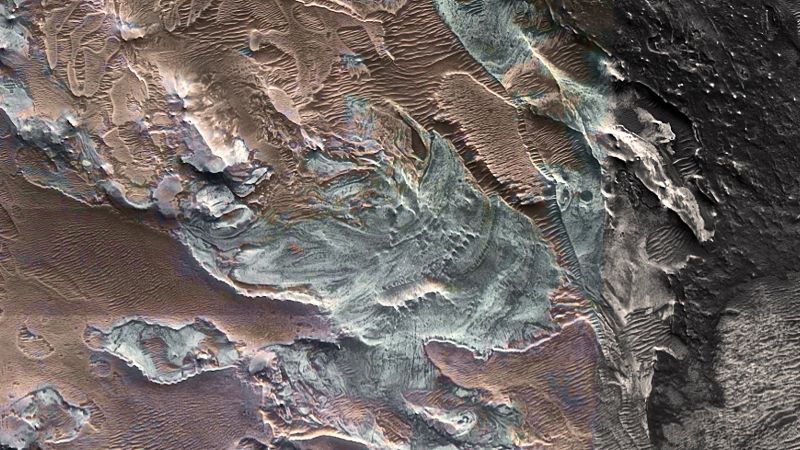(CNN) – Remains of a glacier have been found near the Martian equator, suggesting that some form of water may still exist in an area of the Red Planet that humans might one day reach.
The glacier no longer exists, however Scientists The remains discovered among other mineral deposits near the equatorial region of Mars. The deposits there often contain light-colored sulfate salts.
The salt deposits, shown in light blue, are preserved where a glacier likely existed near the Martian equator.
When the scientists took a closer look, they recognized features of a glacier, including ridges called moraines—debris deposited or pushed up by a moving glacier. The research team also discovered rift fields, or deep wedge-shaped openings, that form within the glaciers.
The results were shared Wednesday at the 54th Lunar and Planetary Science Conference in The Woodlands, Texas.
“What we found is not ice, but rather salt deposits with detailed morphological characteristics of a glacier,” said the study’s lead author, Dr. Pascal Lee, senior planetary scientist at the SETI Institute and the Mars Institute, in a statement. ..
This annotated image shows all the details of where the glacier used to be. (NASA MRO HiRISE / CRISM False Color Composite)
“What we think happened here is that the salt formed on top of a glacier while retaining the shape of the ice below, down to details like fault fields and moraine bands.”
Researchers believe the glacier was 3.7 miles (6 kilometers) long and 2.5 miles (about 4 kilometers) wide, with a height of between 0.8 and 1.1 miles (1.3 to 1.7 kilometers).
Volcanic activity, the key to the glacier
Scientists have an idea of how the glacier footprint might have come about, based on evidence of volcanic material in the area. When a mixture of volcanic ash, lava, and volcanic glass called pumice reacts with water, a hard, scaly layer of salt can form.
Map showing where the remains of the glacier were found near the Martian equator. (Pa Lee)
“This region of Mars has a history of volcanic activity. Should some volcanic material come into contact with icy ice, chemical reactions would have taken place at the boundary between the two to form a solid layer of sulfate salts.” at the University of Maryland, College Park, in a statement.
“This is the most likely explanation for the hydrated and hydroxylated sulfates we observed in this light-colored sediment.”
A geologically small ice surface near the equator
The volcanic material likely eroded away over time, revealing the salty layer that picked up the imprint and distinct characteristics of the glacial ice, said study co-author John Schott, a geologist at the Mars Institute and field guide to ice in the Arctic and Antarctica.
Mars has a thin atmosphere that allows space rocks to collide regularly with the planet’s surface. But the glacier’s subtle, detailed features remain largely intact in the salt deposits, leading the researchers to believe it is relatively “young”.
The study authors said they believe the glacier was present during Mars’ Amazonian geological period, which began 2.9 billion years ago and is still ongoing.
Details of the glacier can be seen in this high-resolution image of the feature. (NASA Imru Hirise/Citi Institute/Pascal Lee)
“We know of glacial activity on Mars in many places, even near the equator at its furthest point. We know about recent glacial activity on Mars, but so far, only at higher latitudes.” “One relatively young glacier at this location tells us that Mars has encountered surface ice recently, even near the equator, which is novel.”
The researchers don’t know if there is any ice left under the reservoir.
“Water ice is currently unstable on Mars near the equator at these altitudes,” Lee told me. “So it is not surprising that we did not detect any water ice on the surface. It may be that all the water ice on the glacier has already sublimated. But there is also the possibility that some part of it is still protected at a shallow depth under the sulfate salts.”
Shallow ice bags may be used
During the study, the team also observed ancient islands of ice called salt flats in the salt flats of the Bolivian Altiplano in South America. Sheets of salts protected the ice of ancient glaciers from melting or evaporating, leading researchers to believe a similar scenario could occur on Mars.
Next, the researchers want to determine if there is any ice left from the glacier, and if so, how shallow there is under the salt deposits. If these salt deposits protect the ice, there may be other ice packs nearby.
Orbits around the planet have shown deposits of ice at Mars’ frigid poles, but if water exists in any form in warmer, lower equatorial latitudes, it could have implications for our understanding of the Red Planet’s history and habitability. .
“The desire to move humans to a place where they can extract water ice from the Earth has led mission planners to consider higher latitude locations,” Li said. But these latter environments are often much cooler and more challenging for humans and robots. If there are tropical locations where shallow ice can be found, we’ll have the best of both environments: warmer conditions for human exploration while still having access to ice.”

“Proud web fanatic. Subtly charming twitter geek. Reader. Internet trailblazer. Music buff.”


:quality(85)/cloudfront-us-east-1.images.arcpublishing.com/infobae/7TXNTX4Z6ZADNGBBYTUT45QETM.jpg)
:quality(85)/cloudfront-us-east-1.images.arcpublishing.com/infobae/TR43PX4FQRCGJOYTK6DVVHHXGE.jpg)


More Stories
NASA finds rock on Mars that may contain ancient microscopic life
Astronauts stranded in space due to Boeing spacecraft malfunction won’t be able to return home for weeks
Download YoWhatsApp Plus 2024 Latest Updated APK for Android | WhatsApp Plus APK